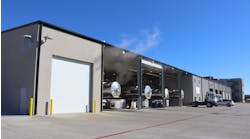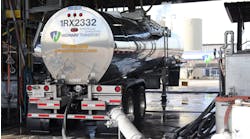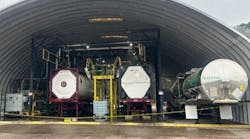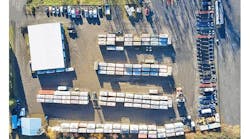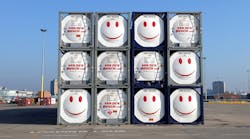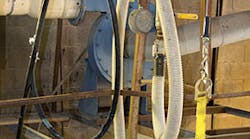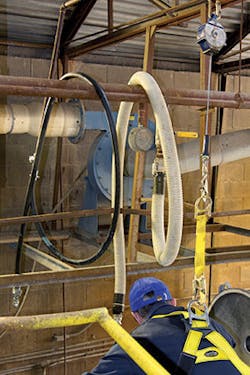KIP Hart, president and chief executive officer of Hart Industries, believes that some of the applications within the tank-cleaning environment are among the most hazardous in the whole tank-truck industry.
And the most critical element is the spinner hose, or process hose, which connects the cleaning-solution piping to the spinner bell, or cone, he said during the National Tank Truck Carriers’ Tank Cleaning & Environmental Council Meeting June 3 and 4 in Denver, Colorado.
“Tank cleaning involves not only high pressures, but extreme temperatures and any number of mixes of cleaning chemicals,” he said “Spinner hoses used to be called caustic hoses because wash racks typically use a 10% caustic solution with hot water. In more recent years, there have been accelerators and other additives in the mix, and oftentimes they’re not calculated into the selection of the hose. There are different chemicals that are being cleaned and recirculated in the cleaning water with that caustic and heat. You kind of have the perfect storm of all the worst possible elements for a hose application: pressure, temperature, chemicals, and the mix of chemicals.”
“The flexing and kinking that can occur during the raising and lowering of the spinner bell create the potential for damage, due to kinking, at the first two feet at either end,” he said. “At a lot of tank washes today, we’re seeing the hoses left connected during raising and lowering, which puts a lot of stress and flexing and sometimes actual kinking at the end of hoses, causing them to go bad prematurely and creating a dangerous environment.
“It’s a bad situation when there’s a hose that’s 200 degrees and 200 psi and a guy is on top of that tank. There is not anywhere to go. We try to apply additional covers. We’re recommending to anybody involved in these operations to put an additional cover over the hose to serve as a bend restrictor and also splash guard, so if the hose does rupture inside, it has an exterior shield that will deflect spray.”
There are special covers that extend hose life by protecting from kinks:
• Special Band-It “Tri-Lokt“ clamping system.
• Crimped (Staked Dog Locked) fittings are attached to the hose.
• “Autolok” cam locks attach the hose assembly to the piping system.
Keeping watch page 2...
Hart said a visual inspection of the cam fittings is critical.
“Oftentimes something that you think would be common sense is passed over,” he said. “These hardware items need to be maintained and inspected regularly. We still see, after years of preaching, a lot of crowfoot fittings being used on steam applications in a tank wash. When a steam hose lets go, it can go on a physical rampage. These couplings are not designed for wash rack applications. They’re designed for air compressor applications below 125 psi.
“Check cam-locks for broken or missing cam arms, cracks or pits in the fitting body, a worn or cracked gasket. Check auto-locks for all the above, plus malfunctioning locking mechanisms. Make sure the locking cam arms are operating properly, creating a positive lock ‘click’ when closed.”
He said “Boss” style fittings with bolted clamps should always be used on steam-service hoses. Bolted clamps should always be checked for tightness. “Staked” crimp fittings can also be used on steam service hoses. Crimp dimensions and method should be approved by the hose manufacture.
“Steam costs money,” he said. “It is an energy source created by burning fuels. Anywhere you have a steam leak, no matter how small it may seem, it’s an ongoing loss of energy and you’re spending a lot of money. These interlocking crimped steam hoses will not leak like the old bolted style. Combine that with the O-ring style, and you can get rid of all leaks in the tank-wash environment.”
He said vigilance is necessary because it’s so much easier to just throw the steam hose into the manway and close the dome lid on it, and because so many trucks come in with crowfeet for their steam connection.
Blower hoses should be free of large kinks, holes, and dry-rot.
Acceptable materials of construction are EPDM, Hypalon, and Santoprene.
Keeping watch page 3...
“Santoprene is resistant to 70% of the common chemicals out there,” he said. “Blower hoses may only be seeing fumes, but they’re still going to age out of the traditional neoprenes and coated fabrics they’re made from. You’re going to get residue and particles coming out of them. With PVC products in the food industry with respect to hoses, the isolation of sources of phthalates and doing away with those is on the horizon. A lot of them use soft clear plastic PVC hoses, and they’re rooting those out. We see a lot of PVC hoses out there being used as blower hoses.”
Hart said return hoses are used to circulate cleaning solution from the tanker back to the process tank.
These hoses can be prone to damage from over-bending, overexposure to chemicals, and heat.
“You can have a tank-truck hose rated to 250 degrees F being cleaned at 190 degrees,” he said. “At 190, that 250-rated hose becomes soft and supple, and it doesn’t take a lot of force to get them to bend, so they can be damaged. They’re also prone to more damage to abrasion at warm temperatures. It’s always advisable to cool them down before you run them in and out of tubes or drag them on the ground. Rinse them in cool water to get the temperature down.”
An air hose should be inspected for external wear, chaffing, cracking, bulges, and fitting condition.
The pump connectors provide flexible connections between pumps and piping to absorb vibration and/or compensating for misalignment.
Water hoses should be of a 200 psi, 200 degree F construction and should be coupled with heavy-duty brass GHT couplings.
“There shouldn’t be any hoses in your tank wash that resemble a garden hose,” Hart said. “I’ve seen plenty of them. We always recommend that hoses be color-coded so you don’t take a black water hose and use it as a steam hose. A lot of heavy-duty water hoses look like a steam hose.
“Never, ever use pressure wands or steam lances to clean the interiors of hoses. Our #1 cause for chemical tank truck hose failure is the cleaning of the interior of hose with a pressure-wash wand. Don’t leave hoses to soak for more than 20 minutes. Vat temperatures should not exceed 180 degrees F.”
Keeping watch page 4...
He listed these tank-wash accessory items carried by Hart Industries: ball and butterfly valves; spinner bells (cones); steamer caps and wands; diaphragm pumps; valve and vent parts (tank truck); gaskets, packings; and tank-truck and industrial piping, including mechanical seals.
He said spinner cones (bells) have a swiveling lift hook to aid in the maneuverability of the bell and premium rubber coverings that are more chemical and heat resistant. Hypalon (tan) or EPDM (white) are used instead of the black SBR covers most common in the tank-wash industry.
“Our vulcanization process involves cleaning, priming, and full autoclave vulcanization of the rubber to the steel,” he said. “This extends the cover life and reduces your costs.
There is also splash-plate design improvement. An angled deflection of the splash plate allows for broader coverage from the spinner for better cleaning on the top and inside wall of the tank interior while preventing the spray from leaking between the spinner bell and manhole.” ♦
